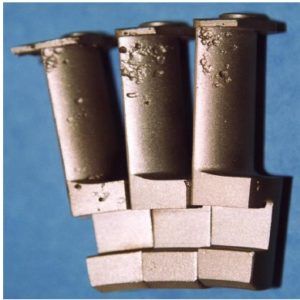Corrosion in turbomachinery
The number one cause of Turbomachinery component deterioration and failures is corrosion damage. The damage is obviously the result of the environment the machinery is operating in.
Common fluids and gases that cause corrosion difficulties include: fresh, distilled, salt and runoff waters, steam condensate; rural, urban, industrial, marine and tropical atmospheres; gases such as steam, chlorine, ammonia, oxygen, sulfur oxides and fuel; mineral acids such as nitric, sulfuric, hydrochloric and organic acids such as acetic, formic and citric.
This article is an excerpt from the paper, "Know your turbomachinery's operation environment" presented by David Linden at the 2018 Turbomachinery Symposium.

Severe steam turbine Rotor blade pitting[/caption]
Turbomachinery corrosion damage can occur from a variety of corrosion mechanisms:
General Surface Corrosion is a uniform corrosive attack over the surface of the part and generally not a problem. Oxidation is a generic form of surface corrosion. Surface corrosion can be beneficial on many materials and is depended upon to prevent further corrosion. This is particularly true in high-temperature alloys that form metal oxides on the surfaces that acts as a barrier to other types of corrosion.
Crevice or Contact Corrosion results when a more aggressive environment is locally created in tight spaces or cavities. Blade attachment, shrouds, riveted components, impeller or wheel fits, spacer regions and even piping connections are all areas susceptible to crevice corrosion.
Erosion Corrosion is the result of a combination of an aggressive chemical environment, the presence of an abrasive media and high fluid surface velocities. Surface erosion causes the removal of surface protective films or coatings and allows corrosion to occur in the base material. It is often associated with multiphase flows.
Exfoliation Corrosion is subsurface corrosion that begins on a clean surface and spreads below it. It differs from pitting in that the attack has a laminated appearance. Exfoliation corrosion is often the source of erosive particulate entering the Turbomachinery flow path.
Fretting Corrosion is a rapid corrosion that occurs at the interface between contacting and highly loaded metal surfaces when subjected to slight vibratory motions. Protective surface films are often broken down and result in the exposure of the base material to the corrosive environment. This type of corrosion is most common on bearing surfaces such at the contact surfaces of axial compressor and turbine blading attachments or centrifugal impeller and coupling hub fits to a shaft.
Galvanic Corrosion is an electrochemical action of two dissimilar metals in the presence of an electrolyte and an electron conductive path. It occurs when dissimilar metals are in contact. A current flow between the metals results in the corrosion of one of the metals in the couple. Proper material selection and the use of component coatings can prevent galvanic corrosion. Intergranular corrosion is a type of corrosion that results from the preferential corrosion of the grain boundary phases in an alloy. Intergranular corrosion is common in high temperature environments and can assist to drive corrosion and cracking rapidly into the base material.
Leaching is the removal of an element(s) in an alloy. The depletion of the leached element results in a base material chemistry change that can greatly reduce the material capabilities. High temperature corrosion products and scales are often found to have high concentrations of the leached element. Nickel and Chromium are two elements that commonly leach from the base materials and form oxide and sulfide corrosion products in highly alloyed gas turbine materials. Pitting corrosion is the local formation of corrosion by which pits, holes, cavities or crevices are produced in the surface of the base material. Pitting corrosion often occurs as the result of corrosive compounds laying on the part surfaces and creating a locally aggressive environment under the deposits.
Pitting corrosion can readily be a crack initiation point in Turbomachinery components and therefore considered to be more dangerous than general surface corrosion. Pitting corrosion is also more difficult to detect, predict and design against. A 40 percent reduction in fatigue strength/stress amplitude can occur from general surface corrosion without pitting, while more than an 80 percent reduction in stress amplitude can occur as the result of pitting corrosion.